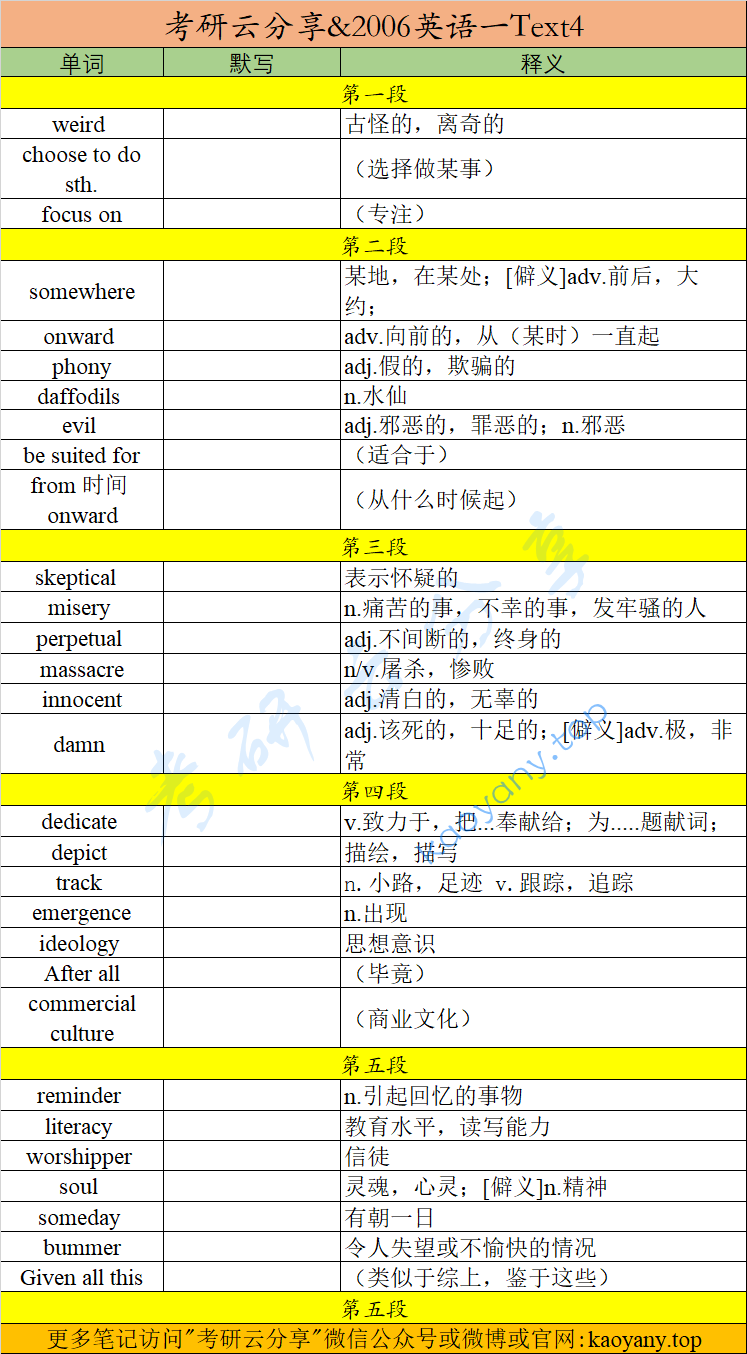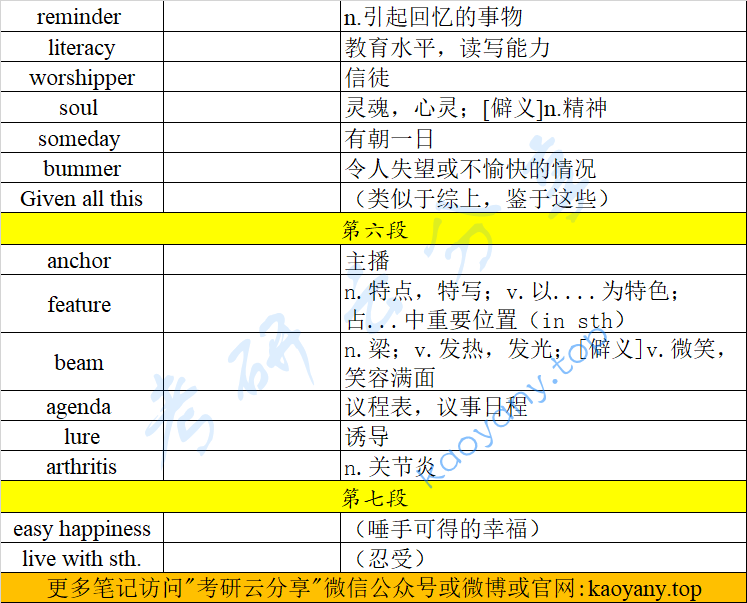第一段
Many things make people think artists are weird. But the weirdest may be this: artists’ only job is to explore emotions, and yet they choose to focus on the ones that feel bad.
单词&词组搭配
weird [wɪrd](出现2次)古怪的,离奇的
choose to do sth.(选择做某事)
focus on(专注)
本段翻译
许多事情让人们认为艺术家古怪的,但是最怪异的或许是这样的:艺术家唯一的工作就是探究情感,但是他们却选择专注于那些让人感觉不好的的情感。
第二段
This wasn’t always so. The earliest forms of art, like painting and music, are those bestsuited for expressing joy. But somewhere from the 19th century onward, more artists began seeing happiness as meaningless, phony or, worst of all, boring, as we went from Words worth’s daffodils to Baudelaire’s flowers of evil.
单词&词组
somewhere(出现2次)某地,在某处;[僻义]adv.前后,大约;
onward [ˈɑːnwərd] adv.向前的,从(某时)一直起
phony [ˈfoʊni] adj.假的,欺骗的
daffodils n.水仙
evil [ˈiːvl](出现4次)adj.邪恶的,罪恶的;n.邪恶
be suited for(适合于)
from 时间 onward(从什么时候起)
本段翻译
情况并非总是如此,最早期的艺术形式,比如绘画和音乐,是最适合表达喜悦的。但从19世纪以来,更多的艺术家开始把幸福看作是无趣的,虚幻的,甚至是使人厌烦的情感,正如我们从哪个华兹华斯的《水仙花》到博德莱尔的《恶之花》所体验到的一样。
PS:《水仙花》与《恶之花》均为诗歌,考试文章取材于西方报刊,学习一门语言除了词汇和语法基础外,文化背景依旧重要。
第三段
You could argue that art became more skeptical of happiness because modern times have seen so much misery. But it’s not as if earlier times didn’t know perpetual war, disaster and the massacre of innocents. The reason, in fact, may be just the opposite: there is too much damn happiness in the world today.
单词&词组
skeptical [ˈskeptɪkl(出现6次)表示怀疑的
misery [ˈmɪzəri](出现6次)n.痛苦的事,不幸的事,发牢骚的人
perpetual [pərˈpetʃuəl](出现1次)adj.不间断的,终身的
massacre [ˈmæsəkər](出现1次)n/v.屠杀,惨败
innocent [ˈɪnəsnt](出现2次)adj.清白的,无辜的,无害的,单纯的;n.无辜的人
damn [dæm](出现2次)该死,诅咒;adj.该死的,十足的;[僻义]adv.极,非常
本段翻译
你可能会辩称,艺术越来越质疑幸福是因为现代社会经历了如此多的苦难。但是早期社会又不会是没有长久的战争,天灾人祸和屠杀无辜。事实上,原因可能恰恰相反:当今世界有太多该死的幸福。
第四段
After all, what is the one modern form of expression almost completely dedicated todepicting happiness? Advertising. The rise of anti-happy art almost exactly tracks theemergence of mass media, and with it, a commercial culture in which happiness is not just an ideal but an ideology.
单词&词组
dedicate [ˈdedɪkeɪt](出现5次)v.致力于,把...奉献给;为.....题献词;
depict [dɪˈpɪkt](出现1次)描绘,描写
track [træk](出现8次)n.小路,足迹,铁轨,跑道;v.跟踪,追踪,留下痕迹
emergence [iˈmɜːrdʒəns](出现2次)n.出现
ideology [ˌaɪdiˈɑːlədʒi](出现2次)思想意识
After all(毕竟)
commercial culture(商业文化)
本段翻译
那么,几乎完全致力于描绘幸福的唯一现代表达形式是什么呢?是广告。反幸福艺术的兴起几乎完全与大众传媒同步,与之同步出现的还有一种商业文化,在这种文化中,幸福不仅是一种理想,更是一种意识形态。
第五段
People in earlier eras were surrounded by reminders of misery. They worked until exhausted, lived with few protections and died young. In the West, before mass communication and literacy, the most powerful mass medium was the church, which reminded worshippers that their souls were in danger and that they would someday be meat for worms. Given all this, they did not exactly need their art to be a bummer too.
单词&词组
reminder [rɪˈmaɪndər] n.引起回忆的事物
literacy [ˈlɪtərəsi](出现3次)教育水平,读写能力
worshipper [ˈwɜːrʃɪpər][词根:worship](出现2次)信徒
soul [soʊl](出现4次)灵魂,心灵;[僻义]n.精神
someday 有朝一日
bummer [ˈbʌmər] 令人失望或不愉快的情况
Given all this(类似于综上,鉴于这些)
本段翻译
早期时代的人们被苦难提示信息团团围住,他们工作到精疲力尽,生活几乎没有保障,而且年纪轻轻的便会死去。在西方,在大众传播和教育普及之前,在这里,信徒们会被提醒:他们的灵魂处于危险之中,他们有朝一日将沦为被虫子啮噬的腐尸。
第六段
Today the messages the average Westerner is surrounded with are not religious but commercial, and forever happy. Fast-food eaters, news anchors, text messengers, all smiling, smiling, smiling. Our magazines feature beaming celebrities and happy families in perfect homes. And since these messages have an agenda—to lure us to open our wallets—they make the very idea of happiness seem unreliable. “Celebrate!” commandedthe ads for the arthritis drug Celebrex, before we found out it could increase the risk ofheart attacks.
单词&词组
anchor [ˈæŋkər] 主播
feature [ˈfiːtʃər](出现11次)n.特点,特写;v.以....为特色;占...中重要位置(in sth)
beam [ˈbiːm](出现1次)n.梁;v.发热,发光;[僻义]v.微笑,笑容满面
agenda [əˈdʒendə] 议程表,议事日程
lure [lʊr] 诱导
arthritis [ɑːrˈθraɪtɪs]n.关节炎
本段翻译
如今围绕普通西方人的信息不是宗教的,而是商业的,且永远都是幸福的。快餐食客,新闻主播,发短信者,都在微笑、微笑、微笑。我们的杂志特载满面春光的名人以及完美住宅里的幸福家庭。由于这些信息有着特点的目的——诱使我们打开钱包——它们使得“幸福”这一概念看起来不可靠。“欢庆吧!”关节炎药西乐葆的广告这样鼓动道,之后我们才发现,它会增加心脏的发病风险。
第七段
But what we forget—what our economy depends on us forgetting—is that happiness is more than pleasure without pain. The things that bring the greatest joy carry the greatest potential for loss and disappointment. Today, surrounded by promises of easy happiness, we need art to tell us, as religion once did, Memento mori: remember that you will die, that everything ends, and that happiness comes not in denying this but in living with it. It’s a message even more bitter than a clove cigarette, yet, somehow, a breath of fresh air.
单词&词组
easy happiness(唾手可得的幸福)
live with sth.(忍受)
本段翻译
但是我们所忘记的——我们的经济依赖的是我们的忘记——是:幸福并非是没有痛苦的快乐。带来最大欢乐的东西很可能带来最大的损失和失望。如今,周围到处都是唾手可得的幸福承诺,我们需要艺术来告诉我们,正如宗教曾经告诉我们,人终究一死,完事皆会结束,幸福不在与否定这一点,而在于忍受它。这是甚至比丁香烟还要苦涩的启示,但不知何故,却带来了一缕清新的空气。
5道题
36. By citing the examples of poets Wordsworth and Baudelaire, the author intends to show that.
[A] poetry is not as expressive of joy as painting or music
[B] art grows out of both positive and negative feelings
[C] poets today are less skeptical of happiness
[D] artists have changed their focus of interest
37. The word "bummer"(Line 5, paragraph 5) most probably means something.
[A] religious
[B] unpleasant
[C] entertaining
[D] commercial
38. In the author's opinion, advertising.
[A] emerges in the wake of the anti-happy art
[B] is a cause of disappointment for the general public[C] replace the church as a major source of information
[D] creates an illusion of happiness rather than happiness itself
39. We can learn from the last paragraph that the author believes.
[A] happiness more often than not ends in sadness
[B] the anti-happy art is distasteful but refreshing
[C] misery should be enjoyed rather than denied
[D] the anti-happy art flourishes when economy booms
40. Which of the following is true of the text?
[A] Religion once functioned as a reminder of misery.
[B] Art provides a balance between expectation and reality.
[C] People feel disappointed at the realities of modern society.
文章概述
本文选自2005年1月17日Times《时代周刊》,原文标题是The Art of Unhappiness(忧愁的艺术)。
本文是一篇关于艺术作用的文章。前三段回顾了艺术在每个阶段上承担的作用并分析了原因。第四、五、六段集中探讨早期快乐和现代快乐的不同的艺术表现形式以及早期艺术家更多地关注快乐和现代艺术家更多地关注悲哀的原因;最后一段作者给出了自己对现代艺术的观点,他认为现代人被过多表现快乐的艺术所包围,需要被痛苦和悲哀加以警戒。
参考答案
DBDBA


- 单词 词组搭配
- 本段翻译
- 单词 词组
- 本段翻译
- 单词 词组
- 本段翻译
- 单词 词组
- 本段翻译
- 单词 词组
- 本段翻译
- 单词 词组
- 本段翻译
- 单词 词组
- 本段翻译
- 5道题
- 文章概述
- 参考答案
